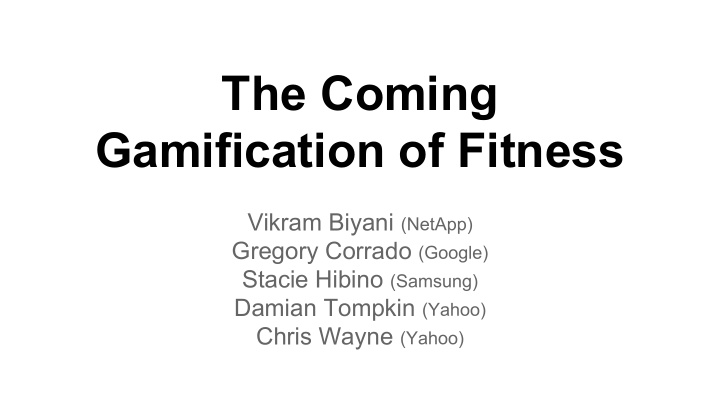



The Coming Gamification of Fitness Vikram Biyani (NetApp) Gregory Corrado (Google) Stacie Hibino (Samsung) Damian Tompkin (Yahoo) Chris Wayne (Yahoo)
Fitness Crisis Americans are overweight and paying the consequences We want to be 51% 79% more fit, but are not being very want to lose don’t get min. successful at it weight exercise
The Evolution of Fitness* Past: Working Out Present: Tracking Fitness Future: Play (fitness games) ? 45M+ members 10% of US Adults owns an activity tracker (9/2013) $27 Billion 2014 revenue of gym, health & fitness clubs *USA-based data
Issues of Long-Term Engagement Past: Working Out Present: Tracking Fitness Future: Play (fitness games) ? Usage: 50%+ activity tracker owners no longer use them
Examples of Fit-Tech Today Wearable Activity Trackers Over 2.7 million wearable bands shipped globally in Q1-2014 alone (roughly half FitBit) Consumer Issues Not sticky. ⅓ of consumers who have owned a device, stopped using it within first 6 months. Business Issues Overcrowded marketplace, lack of differentiating features.
Examples of Fit-Tech Today Leader-board Exercise Apps Strava alone has 6 million monthly pageviews and 14k App reviews Consumer Issues Appeals principally to those who already like to run or bike. Business Issues Poor monetization via “pro” version.
Chief Insight All these issues stem from a failure of available products to motivate and engage users.
Central Question What could successfully motivate human being to engage in physical activity?
Hypothesized Solution Fun, competitive, collaborative games.
Why Fitness Games? 3 behavioral factors for Multiplayer fit-tech long-term engagement*: games address all of these AND they are: ● habit formation ● social motivation ● fun ● goal reinforcement ● playful ● competitive *Endeavor Partners report (Jan 2014): “Inside Wearables: How the Science of Human Behavior Change Offers the Secret to Long-Term Engagement”
The Need Wait, why not just play team sports? Real-world sports demand players be: Fit-tech games ● in the same location could relax any or all ● at the same time of these constraints. ● of roughly similar skill & fitness level As a business opportunity: People spend real money on sports/fitness People spend real money on social games (e.g., CandyCrush) Healthcare providers will pay for better fitness (e.g., Humana)
Early Fit-Tech Gamifications Zombies, Run! Launched exer-tainment Social, but non-competitive, non-collaborative Gaining popularity, 800k downloads. Run An Empire KickStarter; in private beta Competitive and collaborative: basically Risk for runners
How could this happen? (1) Game studio launches a blockbuster fit-game title (2) Cross device fit-game platform, seeded with a few game titles (3) Wearable company invests seriously in fit-game development for their products
Summary Less active $$$ consumers need 79% extrinsic don’t get min. motivation Fitness gamification exercise has business value to be more active for app developers, fitness device makers and healthcare Fitness gamification providers offers a flexible solution for fitness activity at any time, any place
Questions?
Backup Slides
Fitness Crisis ● 34.9% of Americans are overweight ● Estimated annual healthcare cost of obesity: $147B ● Obesity rate in adolescents quadrupled in past 30 years ● 51% of Americans say they want to lose weight ● 79.4% of Americans do not get the American Heart Associations recommend minimum level of exercise ● Annual gym & health club industry revenue: $27B ● 67% of people with gym membership never use them
Summary ● 79%+ of Americans do not get the minimum exercise set by the AHA ● Less active consumers need extrinsic motivation to be more active ● Fitness gamification offers a flexible solution for engaging consumers any time, any place ● Such games have business value for app developers, fitness device makers and healthcare providers
Recommend
More recommend